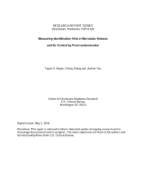
An official website of the United States government
Here’s how you know
Official websites use .gov
A .gov website belongs to an official government organization in the United States.
Secure .gov websites use HTTPS
A lock (
) or https:// means you’ve safely connected to the .gov website. Share sensitive information only on official, secure websites.
-
//
- Census.gov /
- Library /
- Census Working Papers /
- Measuring Identification Risk in Microdata Release and Its Control
Measuring Identification Risk in Microdata Release and Its Control by Post-randomization
Measuring Identification Risk in Microdata Release and Its Control by Post-randomization
Abstract
Statistical agencies often release a masked or perturbed version of survey data to protect respondents' confidentiality. Ideally, a perturbation procedure should protect confidentiality without much loss of data quality, so that released data may practically be treated as original data for making inferences. One major objective is to control the risk of correctly identifying any respondent's records in released data, by matching the values of some identifying or key variables. For categorical key variables, we propose a novel approach to measuring identification risk and setting strict disclosure control goals. The general idea is to ensure that the probability of correctly identifying any respondent or surveyed unit is at most ξ , which is pre- specified. Then, we develop an unbiased post-randomization procedure that achieves this goal for ξ > 1 / 3. The procedure allows substantial control over possible changes to the original data and the variance it induces is of a lower order of magnitude than sampling variance. We apply the procedure to a real data set, where it performs consistently with the theoretical results and quite importantly, shows very little data quality loss.
Others in Series
Working Paper
Working Paper
Working Paper
Share
Related Information
Some content on this site is available in several different electronic formats. Some of the files may require a plug-in or additional software to view.
 Yes
Yes
 No
NoComments or suggestions?


Top

